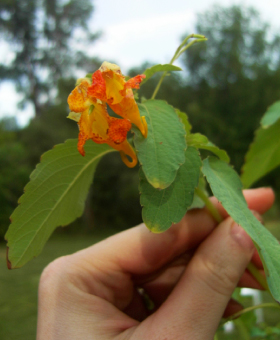Some plants evolve tolerance to deer
By Krishna Ramanujan

Rampant deer have long been munching away on forest plants and altering ecosystems, but new evidence suggests some plants are evolving tolerance to being eaten.
An experiment with 26 populations of orange jewelweed (Impatiens capensis), a common wetland native plant, found that historically browsed populations tolerated being eaten by deer far better than historically protected plant populations.
Deer tolerance was determined by measuring lifetime seed production when faced with being eaten by deer.
The study, recently published online in the Journal of Ecology, found that herbivory by deer reduced lifetime fruit (seed) production by only 20 percent in historically browsed populations, versus reductions of 57 percent in historically protected plants.
The researchers believe that more tolerant plants may put more energy into growing fast to counter being eaten, or in this case, producing more seeds.
“Individuals in populations that were historically browsed were able to devote more resources to seed production,” said Laura Martin, a graduate student in the field of natural resources and the paper’s lead author.
“The flowers last longer and there were more seeds per flower in the historically browsed plants, but there were the same number of flowers in browsed and protected plants,” Martin said.
The findings suggest that either historically browsed populations have evolved increased tolerance due to pressure from deer, or that historically protected populations have lost tolerance over time.
The study provides the first empirical evidence of evolution of tolerance in response to deer herbivory.
Though it was difficult to verify how long plant populations had been protected or browsed, the researchers chose plants from sites estimated to have existed for at least 30 years under protected or browsed conditions.
Protected populations came from such diverse sites as fenced gardens, in gorges on steep slopes where deer could not reach, and within New York City’s Central Park, where the city itself acted as a kind of fence against deer.
“The different types of protection added robustness to our study,” said Martin.
The researchers picked samples from 26 populations around New York state, 13 that were historically browsed and 13 that were historically protected. They then planted them in the Mundy Wildflower Garden in Cornell Plantations, with half the plants inside the deer fence and half outside.
“All of the plants outside the fence were naturally browsed by deer,” and the researchers then compared seed production inside and outside the fence and within populations from which they were collected, said Martin.
While the study adds to understanding of plant tolerance and evolution, it also sheds light on the ability of plant populations to adapt and persist in the face of rapid ecological change.
Co-authors include Anurag Agrawal, professor of ecology and evolutionary biology, and Clifford Kraft, associate professor of natural resources.
Media Contact
Get Cornell news delivered right to your inbox.
Subscribe